Create Emotions From Simple Changes in the Face
by Carlos Gomes Cabral There are millions of eyes, mouths, noses, ears, chins in the world, each with their own characteristics. Howeve...
https://plus.toonsmag.com/2015/08/create-emotions-from-simple-changes-in.html
by
There are millions of eyes, mouths, noses, ears, chins in the world, each with their own characteristics. However, to draw faces in a cartoon style, you just need to understand the basics of them. Once you have mastered these concepts, pay attention to the depth, make sure that the head of your characters give the impression of being three-dimensional and you have mastered the technique of drawing them from every imaginable angle. If you can do that, great! But if you really want to draw attention to your art, you have to master the technique to bring them to life with facial expressions!
Practically anyone can draw a face. You make a circle with some dots and lines and anyone who looks to it will say that it's a face. But, in the same way that it's something easy to build, it can also become difficult when dealing with feelings and emotions...
Behavior of the Human Face
The various expressions of the human face, like the different tones of voice, can be changed with ease. Expressions aren't only result of muscles contraction, but the combined action of several muscles and relaxing of the opposite muscles . The same group act, for example, in both situations of smiling or laughing, only in different intensity levels.
If I ask you to describe exactly what kind of feelings do you identify in the image below, what do you say?

I know what, you'll tell me that the figure gives you a sense of calm and reflection. Maybe he's thinking about something. It's actually none of that! This is actually an image that expresses the complete absence of expression, since none of the facial muscles are being used. We're looking at an absence of emotions, so perhaps calm and relaxed is a good description of the emotion otherwise.
That's OK if you use this expression everyday in your drawings. In fact, this is the expression that people use in 80% of the day! The thing is that these people are only with this face when they are alone, because, when looking to someone else or placing the person into a situation, there is a reaction; that will be answered with another reaction! And when it comes to cartoons, we must exaggerate this effect to the fullest to make it clear to our audience what emotions are being conveyed. [next]
Primary Emotions
The primary emotions are those where we humans, don't have enough control of how they originate. This means that this kind of emotion doesn't have a correct direction. For example, it comes on suddenly, in response to a primary stimulus.
These basic emotions are expressed in our face regardless of culture, race or age. Below I present to you the main ones:

- Happiness (1): Mouth curved upwards - higher eyebrows - eyes wide open;
- Anger (2): Mouth curved downward - eyebrows with the tip slightly lower down - eyes wide open;
- Scared (3): Mouth erratically curved down, higher eyebrows with irregularly shaped - eyes wide open;
- Sadness (4): Mouth curved downward; eyebrows with the tip slightly up - eyes with lower eyelids;
These are the main expressions of the face and we use them most frequently during our lives. For the cartoon, the vast majority of what you will need to develop are those four expressions. From this we can derive the other emotions.
There are two more expressions somewhat lesser known that compose the group of basic expressions:

- Astonished (5): Small and semi-open mouth - higher eyebrows with irregular shaped - eyes wide open;
- Shucks (6): Mouth erratically curved down, lower eyebrows with the tip down - eyes closed;
"Why the hell you separate these two from the first group?" Simple: If you notice, these expressions are variations of expressions in the first group.
Now that you've been introduced to the primary expressions, you must be wondering why they are so few, right? It's simple: Just as there are primary colors, which can be mixed to give life to other colors, primary emotions can also be mixed to create several other secondary expressions! Just take a look:
Notice that, to build a sleepy expression, we took the eyebrows from the happiness expression and mixed with the almost closed eyes of the sadness. Cool, isn't?

Family Emotions
The fun doesn't stop there! The family emotions are those which build similar emotions by changing only one component of the face, finding another emotion!

Notice that only the mouth was modified in the two drawings. We can express two different repulsion feelings just by altering a single element of the face! Here is another example:
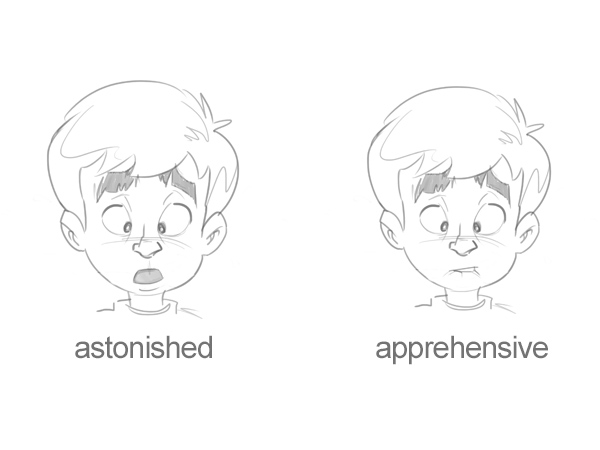
This time we use the mouth and eyes to mount another variant of the same primary emotion.

Not only are primary expressions that give rise to other emotions, we can extract a third emotion from a secondary emotion too. Check it out:

Fantastic, isn't it? It is quite possible that you get dozens or even hundreds of emotional possible faces for your designs applying these techniques! [next]
Physical State Emotions
Emotions from physical states have a concept very close to primary emotions, but, unlike these, can assume several and unpredictable forms.
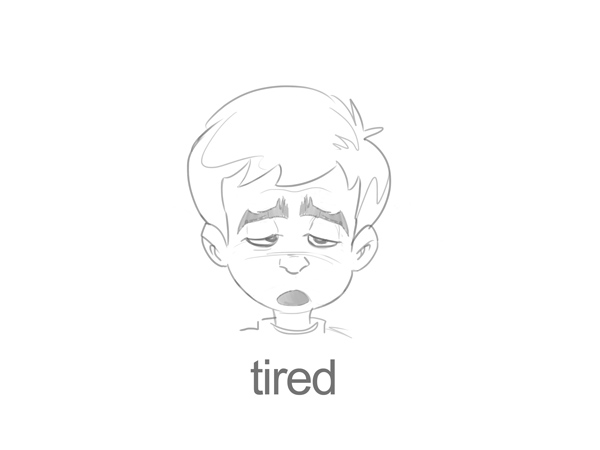
We can enhance an emotion just adding a complementary element, such as expiration drops, for example:
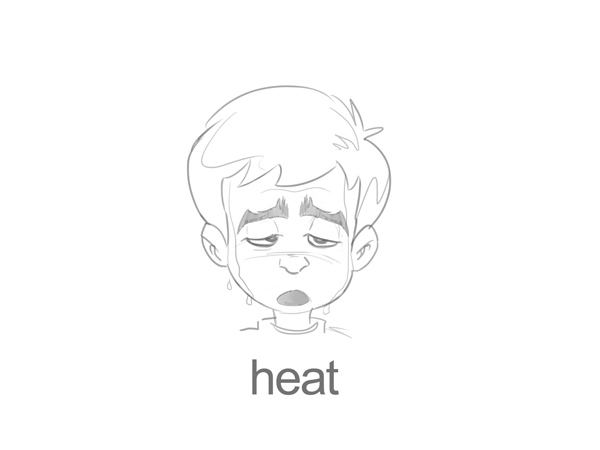
Let's see another example of physical reaction which we do not have much control. This time our character is being exposed to a discharge of electrical current! In a nutshell: completely lost control over your own reaction!

As the reaction of a shock is something we can't control very well, in the cartoon it's an advantage, since we can exaggerate the expression to get the desired result. In this case, we exaggerate the mouth.
Also notice how the primary emotions are dominant. The shock, even being unmanageable, is a variant of fear. The most interesting in relation to physical emotions is that, in real life, we get these expressions without being aware of how we get it, as we are being exposed to external factors and other conditions. [next]
Intensity and Additional Elements
The cartoon facial expressions are not just limited to a specific degree of intensity. Depending on intensity, we can create very interesting results:


Besides the intensity, we can also insert additional elements to enhance the emotions. In the first image we added a few drops of sweat bouncing from the face to reinforce the fear. In the second one, we put the tongue out to strengthen the desired effect.
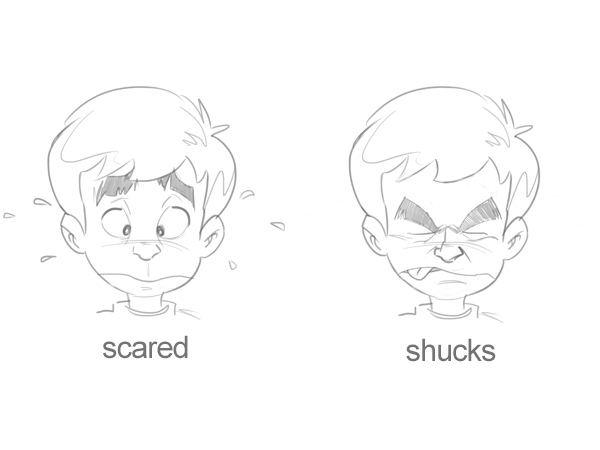
Returning to fear, let's tweak the image to explore a more intense feeling of panic!

Change the Angles
To achieve more impact on expressions and conquer a more dramatic effect it's interesting to change the viewing angle of the scene for more unusual positions. Thus, when setting the viewer at an angle that he is not accustomed to looking at, you put him in an "uncomfortable" situation and makes the scene more dynamic.

Notice that when positioning the angle of the scene from the top down, it's automatically given a inferiority effect for our character, making him "shrink" and look fragile against the threat. In contrast, when positioning our camera from the bottom up, we make our character becomes much more threatening! The prominent chin, the sneer and glare helps to create the perfect atmosphere of threat to him!
In a cartoon style, menacing characters usually have big chins and smaller eyes. However, weaker characters have larger eyes and are more expressive, but have smaller jaws and mouth is always very close to the chin. Try to apply these techniques in your designs and you will see!
Play With Society Stereotypes and Context
To create bigger stereotypes with our characters, we can add subtle elements that strengthen the context of the scene. Some techniques may generate this effect immediately, because of the information we carry throughout our lives. This is due to several factors such as the influence of film, television and figures features of our daily life.
Notice with the drunk: messy hair, unshaven, heavy eyelids and the tooth out of the mouth provide the perfect picture of a sloppy drunk. We grow up to recognize such stereotypical traits for someone under the influence of alcohol over a long period of time. Purposely while the sick guy is with the larger nose and is aged. Eyes closed and saliva drops indicate that your health doesn't goes well.
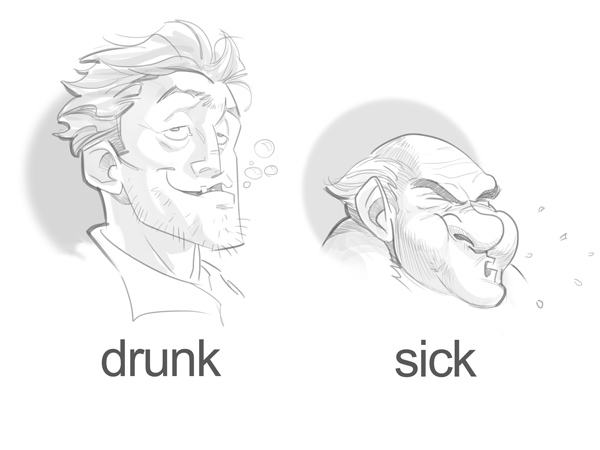
Here's another example. The below picture can be applied in several contexts. I could tell that the man at the top is with a lot of pain, while the man on the bottom is exploding in rage!

Let's insert some additional elements to completely change this perception. Did you realized what we did? By adding the tears on both characters and a tissue, we surely can say that both are crying.
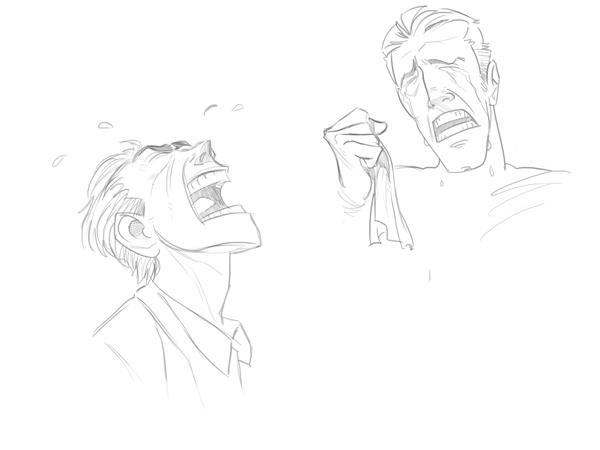
Facial Signals
When we add the many ways to use our expressions in order to send specific signals to other people, our face takes us in different directions. This is because, similarly as physical emotions, we don't have much control of these "signs", which makes us react in unexpected ways, most often guided by the heart.
Below we have a clear example of exchanging signals. The heartthrob directs his fatal gaze to the maiden, in order to use all of his seduction powers to woo her. She responds with a look dominated by passion. Do you think she's fallen for him?

Let's look at another example. The image below is a very common scene in cartoon: The sweet girl doing her "puppy dog eyes" pose, who always gets what she wants with this endearing knack.

Let's change the context of this. We changed only the direction of the eyes, which are now looking away from the person who is ahead of her. This small detail makes her more shy. Pretty cool, huh?

Conclusion
If you have difficulty in expressing feelings and emotions in your characters, a way to achieve better results is imitating any of these expressions in person. This way you will be exercising your own perception and thus enriching your techniques arsenal.
Facial expressions are a very extensive subject that goes far beyond the study of the face to express emotions and feelings in a cartoon style. As has been said before, we have full control of our emotions just as we completely lose control when we are bitten by a dog, for example.
Want to create an interesting experience? Invite the family to take a picture and notice how they all make the same face to smile - this is a controlled emotion, where they pretend their feelings. However, try giving them a hell of a fright and you will see how each is expressed differently when exposed to fear!
I hope you are motivated to practice what you've learned here, about how to express various emotions in your characters. Don't forget that, when drawing cartoons, you need to exaggerate most of these expressions and understand at least the basics of how they are formed to instantly bring identification with the viewer!





